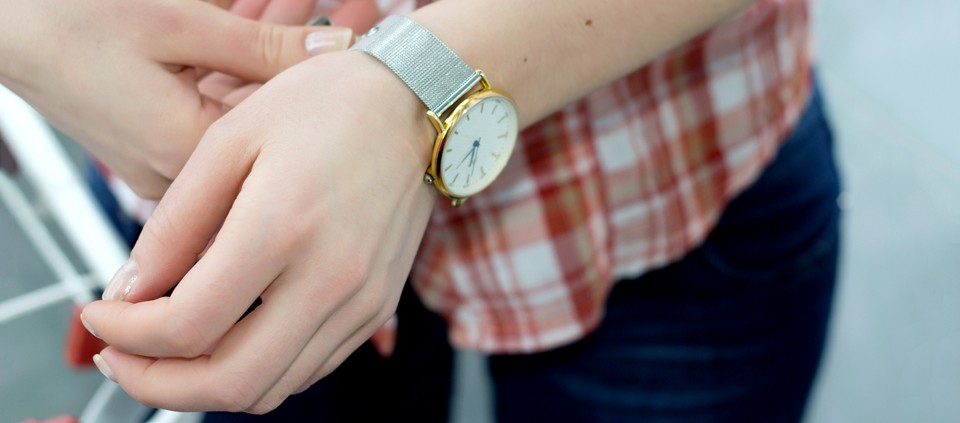Letting Go of Time

by Jennifer Lang
I wanted this visit to be different. It was my third time at Kripalu, and I wanted to mark it. So I did something unfathomable—for me—and took off my watch. Not a simple matter, mind you: It was tantamount to removing my wedding ring, which I've never done in 14 years. That stainless steel object guides my every move—from when to shower early morning, to leave for yoga class mid-morning, to pick up the kids from school late afternoon, to crawl into bed at night.
That said, ever since I got a new watch last year, I’ve developed a ritual of removing it during yoga class. Oftentimes, the clasp opens up during down dog and it dangles loosely on my wrist. Rather than let it interfere with my practice, I lay it down next to my mat and usually forget it’s even there until shavasana begins, which is when I slip it back on again.
But as I was lying in Savasana during my first yoga session on Friday afternoon at Kripalu, I couldn’t quiet my mind. Thousands of thoughts were swirling around in my head: Daily life is stressful, this place is sacred, me-time doesn’t come my way often, make it memorable. With my eyes still closed, I unhooked my watch, less than one minute after having put it back on, deciding instead to hold it in my hand until I reached my room and could put it away for the weekend. After all, I had a program schedule, and there were enough clocks in the building to keep me connected. I glanced up at one in the studio on my way out the door: 5:50 pm.
As I bent down to put on my shoes in the hallway some ten seconds later, I absentmindedly glanced at my wrist. I must do that a hundred times a day, I thought. And I realized how challenging this personal exercise was going to be.
Throughout the weekend, I kept looking at my fellow yogis and yoginis to see how many of them were wearing watches. I would say roughly half. I wondered if those who were watchless were regular non–watch wearers or if they too had a desire to cast aside all ties to the outside world during their stay. Then I wondered what life would be like without watches and clocks. Would my kids, who hear me chanting the time like a mantra every morning—"It’s 7:30, time to eat, get to the table now, please"—feel more relaxed?
If I didn’t wear a watch, would I turn into my friend Carolyn, who chooses not to wear one but who runs on stress-induced adrenaline because she is so disorganized? Or would I become like my husband, who doesn’t like the feel of a watch on his wrist but who opens up his cell phone every 20 minutes to see what time it is? What if I turned into my father, who owns and wears countless watches but who is eternally late for appointments? What might my life be like if I let myself wake up when I felt daylight, ate only when I felt hunger, and went to bed when I was overcome by sleep?
This turning inward in search of answers is known in yoga as swadhyaya or self-study. As Donna Farhi writes in Yoga Mind, Body & Spirit, "Any activity that cultivates self-reflective consciousness can be considered swadhyaya ... Whatever the practice, as long as there is an intention to know yourself through it, and the commitment to see the process through, almost any activity can become an opportunity for learning about yourself."
As I was packing my suitcase at the end of the weekend, I tried to calculate how many times I had caught myself looking down at my wrist. Surprisingly, I finished on four fingers. (Okay, I admit I asked my roommate what time it was twice!) Knowing this filled me with a deep sense of calm. Sure, I could have felt that way because of the benefits of the physical asanas, my newfound knowledge of Anusara Yoga, or the fact that I didn’t have three little people clamoring for my attention for the past 48 hours. But it was more than that: I had survived without knowing what time it was whenever I wanted and I had let go of the need to know. I had confronted my split personality—the me that yearns to live in a watchless world and the me that can’t function without a timepiece. And I sensed that there were, and probably always will be, many more layers to uncover in my divided self. This friendly confrontation was not a done deal as much as it was a beginning, an unearthing of sorts.
As I pulled my old friend out of my purse and fastened it back on my wrist, I smiled to myself, knowing that I would welcome the opportunity to delve beneath the surface again and again.
Jennifer Lang is a yoga instructor and writer who lives in Raanana, Israel, where she blogs about her adventures at opentoisrael.com.
© Kripalu Center for Yoga & Health. All rights reserved. To request permission to reprint, please e-mail editor@kripalu.org.